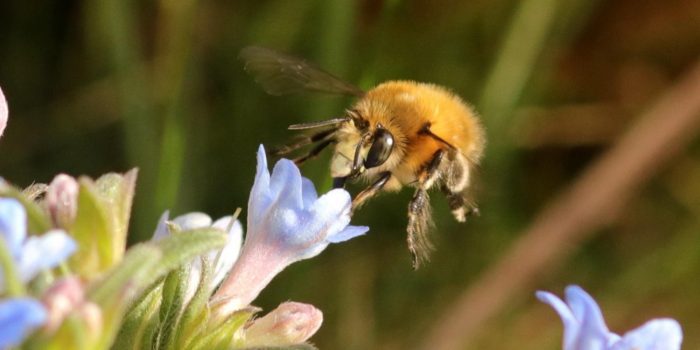In April 2010 I saw a small black bee-sized dot charging across the garden. It was almost too fast for the human eye to keep pace with and quickly disappeared over the garden wall.
Over the next few days I managed to photograph the bee feeding on Lungwort Pulmonaria officinalis and Shrubby Gromwell Lithodora fruticosa and identified it as the Hairy-footed Flower Bee Anthophora plumipes.
Hairy-footed Flower Bees are heralds of spring time and a welcome addition to any garden. The bee is sexually dimorphic, the females are black haired with an orange pollen brush on the hind legs and the males are a more colourful mix of tawny and dark hairs. The males also have a fringe of very long hairs on all segments of the mid tarsi (the final five segments of their legs) and a creamy yellow face.

There are five species of flower bee in Great Britain and Ireland and 450 worldwide. Prior to the mid-2000s this species was at the northern edge of its range in Derbyshire and was probably quite rare. In the last ten years it has expanded its range and is now relatively common with many records coming from gardens where favoured food plants such as Lungwort, comfreys, gromwells and Green Alkanet Pentaglottis sempervirens are often to be found. There are now records as far north as Scotland, though it is still more abundant further south.

Flower bees are solitary (though nests may be aggregated) and in my experience the males emerge on average around 7 – 14 days earlier than the females, perhaps to give them time to scout likely nectar sources to which females will be attracted in the coming days.
Males act in a territorial fashion and I’ve witnessed several males at a time acrobatically battling in an engrossing ‘bee-fight’ before the vanquished male gives up and tries his luck elsewhere.
Once mated, females find nest sites in walls, holes in wood, cliffs and sometimes in the ground, where soils are suitable. The males disappear in late April and May whilst females remain busy for several weeks provisioning their nests. They are usually gone by early June.
A later emerging species has also recently appeared in the garden (July 2019) the Fork-tailed Flower Bee Anthophora furcata.
Most bees have parasites and for a while at least it seemed that the Hairy-footed Flower Bee had outrun one of its main cleptoparasites the Common Mourning Bee Melecta albifrons, but in April 2017 I found this in the garden and again last year.
Fortunately not all of the nests get parasitized and this year the first male Hairy-footed Flower Bee appeared on 20th March as I started what may be an extended period of garden wildlife watching! The first female appeared a day later suggesting perhaps that the males have been around for a week or so, but gone unnoticed?
I shall continue to keep tabs on the bees over the next few weeks and who knows maybe I’ll be able to track a female back to a nest this year?


